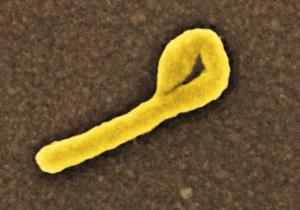By Vincent Racaniello, PhD
An otherwise balanced review of selected aspects of Ebolavirus transmission falls apart when the authors hypothesize that ‘Ebola viruses have the potential to be respiratory pathogens with primary respiratory spread.’

The idea that Ebolavirus might become transmitted by the respiratory route was suggested last year by Michael Osterholm in a Times OpEd. That idea was widely criticized by many virologists, including this writer. Now he has recruited 20 other authors, including Ebola virologists, in an attempt to lend legitimacy to his hypothesis. Unfortunately the new article adds no new evidence to support this view.
In the last section of the review article the authors admit that they have no evidence for respiratory transmission of Ebolavirus:
It is very likely that at least some degree of Ebola virus transmission currently occurs via infectious aerosols generated from the gastrointestinal tract, the respiratory tract, or medical procedures, although this has been difficult to definitively demonstrate or rule out, since those exposed to infectious aerosols also are most likely to be in close proximity to and in direct contact with an infected case.
It is possible that some short-distance transmission of Ebolavirus occurs through the air. But claiming that it is ‘very likely’ to be taking place is an overstatement considering the lack of evidence. As might be expected, ‘very likely’ is exactly the phrase picked up by the Washington Post.
I find the lack of critical thinking in the following paragraph even more disturbing:
To date, investigators have not identified respiratory spread (either via large droplets or small-particle aerosols) of Ebola viruses among humans. This could be because such transmission does not occur or because such transmission has not been recognized, since the number of studies that have carefully examined transmission patterns is small. Despite the lack of supportive epidemiological data, a key additional question to ask is whether primary pulmonary infections and respiratory transmission of Ebola viruses could be a potential scenario for the future.
Why is the possibility of respiratory transmission of Ebolaviruses a ‘key additional question’ when there has been no evidence for it to date? To make matters worse, the authors have now moved from short-range transmission of the virus by droplets, to full-blown respiratory aerosol transmission.
The authors present a list of reasons why they think Ebolavirus could go airborne, including: isolation of Ebolaviruses from saliva; presence of viral particles in pulmonary alveoli on human autopsies; and cough, which can generate aerosols, can be a symptom of Ebolavirus disease. The authors conclude that because of these properties, the virus would not have to change very much to be transmitted by aerosols.
LISTEN: Ebola Q & A with infectious disease experts Smith and Racaniello
I would conclude the opposite from this list of what Ebolavirus can do: there is clearly a substantial block to respiratory transmission that the virus cannot overcome. Perhaps the virus is not stable enough in respiratory aerosols, or there are not enough infectious viruses in aerosols to transmit infection from human to human. Overcoming these blocks might simply not be biologically possible for Ebolavirus. A thoughtful discussion of these issues is glaringly absent in the review.
The conclusion that Ebolavirus is ‘close’ to becoming a full-blown respiratory pathogen reveals how little we understand about the genetic requirements for virus transmission. In fact the authors cannot have any idea how ‘close’ Ebolavirus is to spreading long distances through the air.
It is always difficult to predict what viruses will or will not do. Instead, virologists observe what viruses have done in the past, and use that information to guide their thinking. If we ask the simple question, has any human virus ever changed its mode of transmission, the answer is no. We have been studying viruses for over 100 years, and we’ve never seen a human virus change the way it is transmitted. There is no evidence to believe that Ebolavirus is any different.
Viruses are masters of evolution, but apparently one item lacking from their repertoire is the ability to change the way that they are transmitted.
Such unfounded speculation would largely be ignored if the paper were read only by microbiologists. But Ebolavirus is always news and even speculation does not go unnoticed. The Washington Post seems to think that this review article is a big deal. Here is their headline: Limited airborne transmission of Ebola is ‘very likely’ new analysis says.
Gary Kobinger, one of the authors, told the Washington Post that ‘we hope that this review will stimulate interest and motivate more support and more scientists to join in and help address gaps in our knowledge on transmission of Ebola’. Such hope is unrealistic, because few can work on this virus, which requires the highest levels of biological containment, a BSL-4 laboratory.
I wonder if Osterholm endorses Kobinger’s hopes. After all, he opposed studies of influenza virus transmission in ferrets, claiming that they are too dangerous. And the current moratorium on research that would help us understand aerosol transmission of influenza viruses is a direct result of objections by Osterholm and his colleagues about this type of work. The genetic experiments that are clearly needed to understand the limitations of Ebolavirus transmission would never be permitted, at least not with United States research dollars.
The gaps in our understanding of virus transmission are considerable. If virologists are not able to carry out the necessary experiments to fill these gaps, all we will have is rampant and unproductive speculation.
Dr. Vincent Racaniello is a Professor of Microbiology and Immunology at Columbia University


One thought on “Virologist: Ebolavirus will not become a respiratory pathogen”